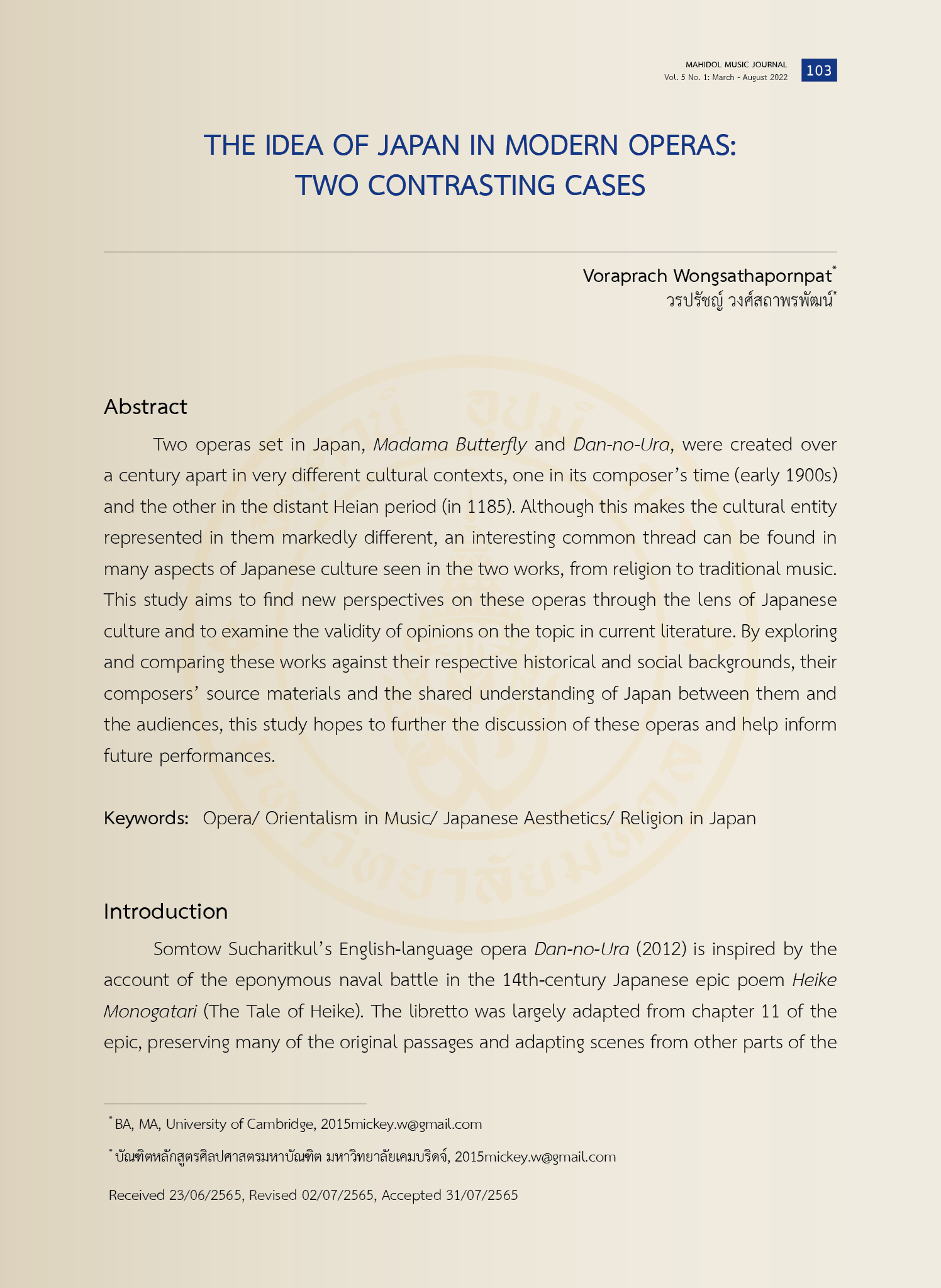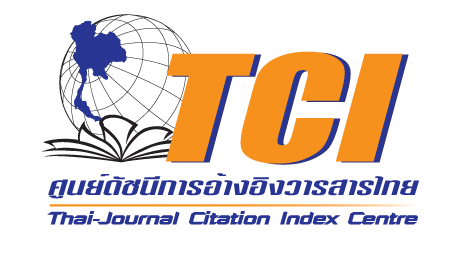THE IDEA OF JAPAN IN MODERN OPERAS: TWO CONTRASTING CASES
Keywords:
Opera, Orientalism in Music, Japanese Aesthetics, Religion in JapanAbstract
Two operas set in Japan, Madama Butterfly and Dan-no-Ura, were created over a century apart in very different cultural contexts, one in its composer’s time (early 1900s) and the other in the distant Heian period (in 1185). Although this makes the cultural entity represented in them markedly different, an interesting common thread can be found in many aspects of Japanese culture seen in the two works, from religion to traditional music. This study aims to find new perspectives on these operas through the lens of Japanese culture and to examine the validity of opinions on the topic in current literature. By exploring and comparing these works against their respective historical and social backgrounds, their composers’ source materials and the shared understanding of Japan between them and the audiences, this study hopes to further the discussion of these operas and help inform future performances.
References
Adami, Giuseppe, ed. Letters of Giacomo Puccini: Mainly Connected with the Composition and Production of His Operas. Philadelphia: J. P. Lippincott, 1931.
Belasco, David. “Madame Butterfly: A Tragedy of Japan.” Columbia University. http://www.columbia.edu/itc/music/NYCO/butterfly/images/belasco_sm.pdf.
Breen, John. and Mark Teeuwen. A New History of Shinto. Chichester: Blackwell Publishing, 2010.
Budden, Julian. Puccini: His Life and Works. Oxford: Oxford University Press, 2006.
Carner, Mosco. Madam Butterfly. London: Breslich & Foss, 1979.
Carner, Mosco. Major and Minor. London: Duckworth, 1980.
Cooke, Mervyn, ed. The Cambridge Companion to Twentieth-century Opera (Cambridge Companions to Music). Cambridge University Press, 2005.
Garfias, Robert. Music of a Thousand Autumns: The Tōgaku style of Japanese Court Music. London: University of California Press, 1975.
Gayuski, Stan. “Somtow delivers a samurai epic.” The Nation. https://www.nationthailand.com/life/30241371.
Greenwald, Helen. “Picturing Cio-Cio-San: House, screen, and ceremony in Puccini’s Madama Butterfly.” Cambridge Opera Journal 12, no. 3 (November 2000): 237-259. https://www.jstor.org/stable/3250716#metadata_info_tab_contents.
Groos, Arthur. “Cio-Cio-San and Sadayakko Japanese Music-Theater in Madam Butterfly.” Monumenta Nipponica: Studies on Japanese Culture Past and Present 54, no. 1 (January 1999): 41-74. https://doi.org/10.2307/2668273.
Groos, Arthur. “Return of the native: Japan in Madama Butterfly / Madama Butterfly in Japan.” Cambridge Opera Journal 1, no. 2 (July 1989): 167-194. https://www.jstor.org/stable/823590#metadata_info_tab_contents.
Hara, Kunio. “Puccini's Use of Japanese Melodies in Madama Butterfly.” Master’s thesis, University of Cincinnati, 2003
Iggulden, Amy. “Opera expert says Puccini's Butterfly is 'racist'.” The Telegraph. https://www.telegraph.co.uk/news/uknews/1542633/Opera-expert-says-Puccinis-Butterfly-is-racist.html.
Illica, Luigi, and Giuseppe Giacosa. “Madama Butterfly - Tragedia giapponese.” http://www.librettidopera.it/butterfly/butterfly.html.
Kerman, Joseph. Opera as Drama. Berkeley: University of California Press, 1988.
Long, John L. “Madame Butterfly.” American Studies. http://xroads.virginia.edu/~hyper/long/cover.html.
Loti, Pierre. “Madame Chrysanthème.” Project Gutenberg. https://gutenberg.org/files/3995/3995-h/3995-h.htm.
McCullough, Helen C. The Tale of Heike. Stanford: Stanford University Press, 1988.
Okamura, Takao. “The revised edition of Puccini's Madama Butterfly.” NPO Opera del Popolo. http://www.minna-no-opera.com/eng/opera/2004_btt_gui_e.htm.
Parkes, Graham. “Japanese Aesthetics.” in The Stanford Encyclopedia of Philosophy. Published December 12, 2005. https://plato.stanford.edu/entries/japanese-aesthetics/.
Potter, Tom. “Japanese Songs in Puccini's Madama Butterfly.” Daisyfield. http://daisyfield.com/music/htm/-colls/Puccini.htm.
Proudfoot, Michael. “Review of “Dan-no-Ura”, Thailand Cultural Centre, 11th and 12th August.” Somtow. http://www.somtow.com/new-page-2/.
Puccini, Giacomo. Madame Butterfly: Full Score. Milan: Ricordi, 2000.
Rij, Jan van. Madame Butterfly: Japonisme, Puccini, and the Search for the Real Cho-Cho-San. Berkeley: Stone Bridge Press, 2001.
Scott, Derek B. “Orientalism and Musical Style.” The Musical Quarterly 82, no. 2 (Summer 1998): 309-335. http://www.jstor.org/stable/742411.
Sheppard, W. Anthony. “Music Box as Muse to Puccini’s ‘Butterfly’.” The New York Times. https://www.nytimes.com/2012/06/17/arts/music/puccini-opera-echoes-a-music-box-at-the-morris-museum.html.
Sheppard, W. Anthony. “Puccini's Madama Butterfly & Morris Museum's 1877 Musical Box: “Shiba mo” (The Eighteen Touches).” Morris Museum. YouTube video. November 29, 2012. https://www.youtube.com/watch?v=LhatQ4hTF_A.
Somtow Sucharitkul. Dan-no-Ura - complete full score. Bangkok: unpublished, 2012.
Sonica. “Sho.” http://sonica.jp/instruments/index.php/en/products/sho.
Tanizaki, Junichiro. “In Praise of Shadows.” http://pdf-objects.com/files/In-Praise-of-Shadows-Junichiro-Tanizaki.pdf.
Wilson, Alexandra. The Puccini Problem: Opera, Nationalism and Modernity. New York: Cambridge University Press, 2007.
Wilson, Conrad. Giacomo Puccini. New York: Phaidon Press, 2008.
Wisenthal, Jonathan, ed. A Vision of the Orient: Texts, Intertexts, and Contexts of Madame Butterfly. Toronto: University of Toronto Press, 2006.
Wooster, Martin M. “Operacon Report.” File770. http://file770.com/?p=21462.

Downloads
Published
How to Cite
Issue
Section
License

This work is licensed under a Creative Commons Attribution-NonCommercial-NoDerivatives 4.0 International License.
The copyright of the article belongs to the author. Published articles represent the views of the authors. The editorial team neither necessarily agree with nor take any responsibility for the article.





